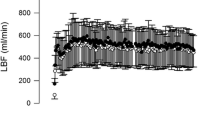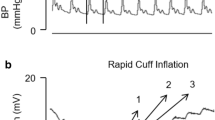Abstract
This study explored the accuracy with which venous occlusion plethysmography (VOP) assesses the hyperaemic response during calf exercise. Using Doppler ultrasound (DU) as a criterion standard technique, we tested the hypotheses that leg blood flow during contraction is not greater than at rest and that VOP provides similar estimates of the hyperaemic response between contractions as DU. Eleven subjects performed several bouts of calf exercise across a wide range of forces (50–400 N ≅ 6–45%MVC). Each bout consisted of 2 min of intermittent contractions preceded and immediately followed by sustained (40 s) contractions. DU estimates of leg blood flow during the sustained contractions were never significantly greater (P > 0.05) than those measured at rest. Paired (DU and VOP) estimates of leg blood flow (n = 488) were obtained between intermittent contractions and ranged between ~50–900 ml min−1. There was a strong correlation between these DU and VOP estimates (Pearson r = 0.91; P < 0.05). Ordinary least products regression analysis, with VOP as the y variable, showed a relatively small proportional bias (slope = 0.942; CI = 0.938–0.946) and fixed bias (y intercept = −13.3 ml min−1; CI = −14.4 to −12.2 ml min−1) between the two measurement techniques. Since these small biases can be explained by the slight differences in vascular regions which the two techniques assess, these data suggest that VOP can accurately assess the hyperaemic response to exercise.







Similar content being viewed by others
References
Adiseshiah M, Barber RW, Szaz KF (1984) Measurement of regional lower limb blood flow in normal humans by inhalation of 133Xe. Eur J Nucl Med 9:379–381
Albracht K, Arampatzis A, Baltzopoulos V (2008) Assessment of muscle volume and physiological cross-sectional area of the human triceps surae muscle in vivo. J Biomech 41:2211–2218
Andersen P, Saltin B (1985) Maximal perfusion of skeletal muscle in man. J Physiol 366:233–249
Anderson JD, Epstein FH, Meyer CH, Hagspiel KD, Wang HK, Berr SS, Harthun NL, Weltman A, DiMaria JM, West AM, Kramer CM (2009) Multifactorial determinants of functional capacity in peripheral arterial disease uncoupling of calf muscle perfusion and metabolism. J Am Coll Cardiol 54:628–635
Barcroft H, Millen JLE (1939) The blood flow through muscle during sustained contraction. J Physiol 97:17–31
Barker G, Green S, Askew C, Green A, Walker P (2001) Effect of propionyl-l-carnitine on exercise performance in peripheral arterial disease. Med Sci Sports Exerc 33:1415–1422
Barker GA, Green S, Green AA, Walker PJ (2004) Walking performance, oxygen uptake kinetics and resting muscle pyruvate dehydrogenase complex activity in peripheral arterial disease. Clin Sci 106:241–249
Bauer TA, Regensteiner JG, Brass EP, Hiatt WR (1999) Oxygen uptake kinetics during exercise are slowed in patients with peripheral arterial disease. J Appl Physiol 87:809–816
Bernink PJLM, Lubbers J, Barendsen GJ, van den Berg J (1982) Blood flow in the calf during and after exercise: measurements with Doppler ultrasound and venous occlusion plethysmography in healthy subjects and in patients with arterial occlusive disease. Angiology 33:146–160
Boushel R, Langberg H, Green S, Skovgaard D, Bulow J, Kjaer M (2000) Blood flow and oxygenation in peritendinous tissue and calf muscle during dynamic exercise in humans. J Physiol 524.1:305–313
Boyd J, Buick J, Green S (2006) A second order accurate lattice Boltzmann non-Newtonian flow model. J Phys A Math Gen 39:14241–14247
Bylund-Fellenius AC, Walker PM, Elander A, Holm S, Schersten T (1981) Energy metabolism in relation to oxygen partial pressure in human skeletal muscle during exercise. Biochem J 200:247–255
Bystrom S, Jensen B, Jensen-Urstad M, Lindblad LE, Kilbom A (1998) Ultrasound-Doppler technique for monitoring blood flow in the brachial artery compared with occlusion plethysmography of the forearm. Scand J Clin Lab Invest 58:569–576
Egana M, Green S (2005) Effect of body tilt on calf muscle performance and blood flow in humans. J Appl Physiol 98:2249–2258
Gaffney FA, Sjogaard G, Saltin B (1990) Cardiovascular and metabolic responses to static contraction in man. Acta Physiol Scand 138:249–258
Gonzalez-Alonso J, Mortensen SP, Dawson EA, Secher NH, Damsgaard R (2006) Erythrocytes and the regulation of human skeletal muscle blood flow and oxygen delivery: role of erythrocyte count and oxygenation state of haemoglobin. J Physiol 572:295–305
Green S (2002) Haemodynamic limitations and exercise performance in peripheral arterial disease. Clin Physiol Funct Imaging 22:81–91
Heinonen I, Nesterov SV, Kemppainen J, Nuutila P, Knuuti J, Laitio R, Kjaer M, Boushel R, Kalliokoski KK (2007) Role of adenosine in regulating the heterogeneity of skeletal muscle blood flow during exercise in humans. J Appl Physiol 103:2042–2048
Hiatt WR, Huang SY, Regensteiner JG, Micco AJ, Ishimoto G, Manco-Johnson M, Drose J, Reeves JT (1989) Venous occlusion plethysmography reduces arterial diameter and flow velocity. J Appl Physiol 66:2239–2244
Hiatt WR, Brass EP, Green S (2004) Skeletal muscle metabolic changes in peripheral arterial disease contribute to exercise intolerance: a point-counterpoint discussion. Vasc Med 9:293–301
Hughson RL, Tschakovsky ME, Houston ME (2001) Regulation of oxygen consumption at the onset of exercise. Exerc Sport Sci Rev 29:129–133
Jorfeldt L, Rutberg H (1990) Comparison of dye-dilution and plethysmographic blood flow measurements: an evaluation of the influence of invasive techniques on blood flow and on arterial and femoral venous substrate variables in man. Clin Sci 79:81–87
Jorfeldt L, Vedung T, Forsstrom E, Henriksson J (2003) Influence of leg position and environmental temperature on segmental volume expansion during venous occlusion plethysmography. Clin Sci 104:599–605
Joyner MJ, Dietz NM, Shepherd JT (2001) From Belfast to Mayo and beyond: the use and future of plethysmography to study blood flow in human limbs. J Appl Physiol 91:2431–2441
Kagaya A, Homma S (1997) Brachial arterial blood flow during static handgrip exercise of short duration at varying intensities studied by a Doppler ultrasound method. Acta Physiol Scand 160:257–265
Kalliokoski KK, Laaksonen MS, Takala TO, Knuuti J, Nuutila P (2003) Muscle oxygen extraction and perfusion heterogeneity during continuous and intermittent static exercise. J Appl Physiol 94:953–958
Kaulesar Sukul DMKS, den Hoed PT, Johannes EJ, van Dolder R, Benda E (1993) Direct and indirect methods for the quantification of leg volume: comparison between water displacement volumetry, the disk model method and the frustum sign model method, using the correlation coefficient and the limits of agreement. J Biomed Eng 15:477–480
Knox R, Cramer M, Fell G, Breslau P, Beach K, Strandness DE (1982) Pitfall of venous occlusion plethysmography. Angiology 33:268–276
Koskolou M, Calbet JA, Radegran G, Roach RC (1997) Hypoxia and the cardiovascular response to dynamic knee-extensor exercise. Am J Physiol 272:H2655–H2663
Lassen NA, Kampp M (1965) Calf muscle blood flow during walking studied by the Xe133 method in normals and in patients with intermittent claudication. Scand J Clin Lab Invest 17:447–453
Longhurst J, Capone RJ, Mason DT, Zelis R (1974) Comparison of blood flow measured by plethysmograph and flowmeter during steady state forearm exercise. Circulation 49:535–540
Lubbers J, Bernink PJLM, Barendsen GJ, vab den Berg JW (1979) A continuous wave Doppler velocimeter for monitoring blood flow in the popliteal artery, compared with venous occlusion plethysmography of the calf. Pflugers Arch 382:241–248
Ludbrook J (1997) Comparing methods of measurement. Clin Exp Pharmacol Physiol 24:193–203
Pallares LCM, Deane CR, Baudouin SV, Evans TW (1994) Strain gauge plethysmography and Doppler ultrasound in the measurement of limb blood flow. Eur J Clin Inv 24:279–286
Pernow B, Saltin B, Wahren J, Cronestrand R, Ekestrom S (1975) Leg blood flow and muscle metabolism in occlusive arterial disease of the leg before and after reconstructive surgery. Clin Sci Mol Med 49:265–275
Radegran G (1997) Ultrasound Doppler estimates of femoral artery blood flow during dynamic knee extensor exercise in humans. J Appl Physiol 83:1383–1388
Radegran G (1999) Limb and skeletal muscle blood flow measurements at rest and during exercise in human subjects. Proc Nutr Soc 58:887–898
Radegran G, Saltin B (1998) Muscle blood flow at onset of dynamic exercise in humans. Am J Physiol 43:H314–H322
Richardson D (1981) Blood flow response of human calf muscles to static contractions at various percentages of MVC. J Appl Physiol 51:929–933
Richardson D, Shewchuk R (1980) Effects of contraction force and frequency on postexercise hyperemia in human calf muscles. J Appl Physiol 49:649–654
Roberts DH, Tsao Y, Breckenridge AM (1986) The reproducibility of limb blood flow measurements in human volunteers at rest and after exercise by using mercury-in-Silastic strain gauge plethysmography under standardised conditions. Clin Sci 70:635–638
Saltin B (2007) Exercise hyperaemia: magnitude and aspects on regulation in humans. J Physiol 583.3:819–823
Saunders NR, Pyke KE, Tschakovsky ME (2005) Dynamic response characteristics of local muscle blood flow regulatory mechanisms in human forearm exercise. J Appl Physiol 98:1286–1296
Sorlie D, Myhre K (1978) Lower leg blood flow in intermittent claudication. Scand J Clin Lab Invest 38:171–179
Tschakovsky ME, Shoemaker JK, Hughson RL (1995) Beat-by-beat forearm blood flow with Doppler ultrasound and strain-gauge plethysmography. J Appl Physiol 79:713–719
Tschakovsky ME, Saunders NR, Webb KA, O’Donnell DE (2006) Muscle blood flow dynamics at exercise onset: Do the limbs differ? Med Sci Sports Exerc 38:1811–1818
Walloe L, Wesche J (1988) Time course and magnitude of blood flow changes in the human quadriceps muscles during and following rhythmic exercise. J Physiol 405:257–273
Whitney RJ (1953) The measurement of volume changes in human limbs. J Physiol 121:1–27
Acknowledgments
The authors thank Dr Mike Herr (Pennsylvania State University) for constructing and supplying the quadrature audio demodulator, Dr Mike Proctor for facilitating our interactions with Dr Herr, Dr Deidre Stuart for writing the MATLAB program used to analyse data collected from the 2010 cohort of subjects, and Dr Paul Hessian for his thoughtful comments on a draft of this manuscript. This study was supported by a University of Otago Research Grant awarded to SG.
Author information
Authors and Affiliations
Corresponding author
Additional information
Communicated by Narihiko Kondo.
Rights and permissions
About this article
Cite this article
Green, S., Thorp, R., Reeder, E.J. et al. Venous occlusion plethysmography versus Doppler ultrasound in the assessment of leg blood flow during calf exercise. Eur J Appl Physiol 111, 1889–1900 (2011). https://doi.org/10.1007/s00421-010-1819-6
Received:
Accepted:
Published:
Issue Date:
DOI: https://doi.org/10.1007/s00421-010-1819-6




